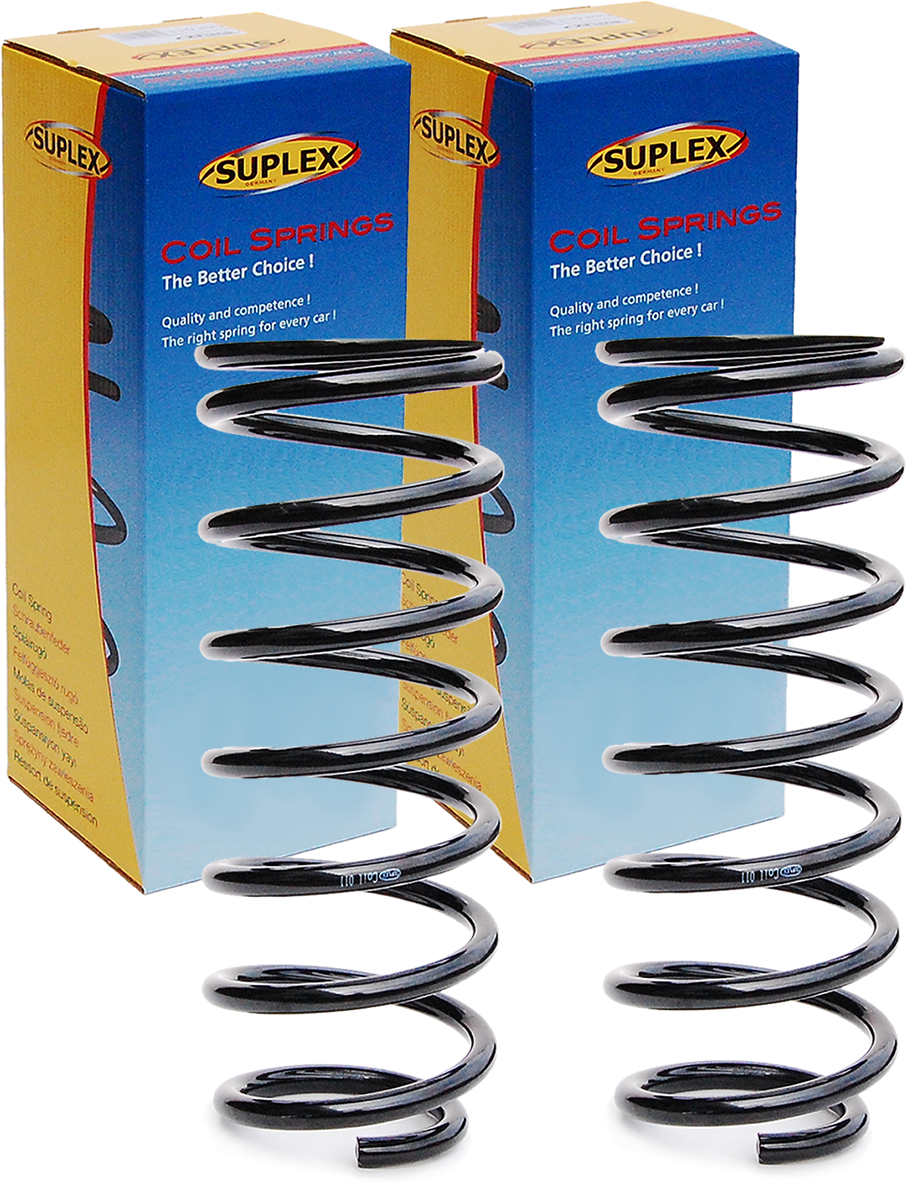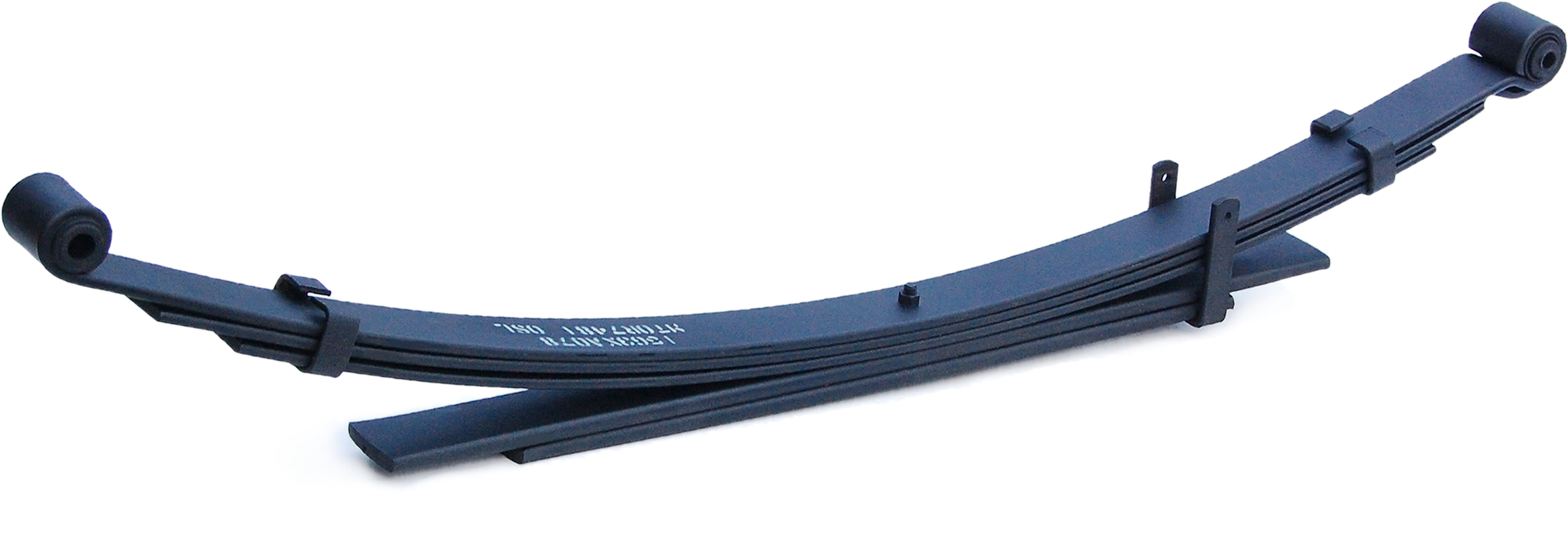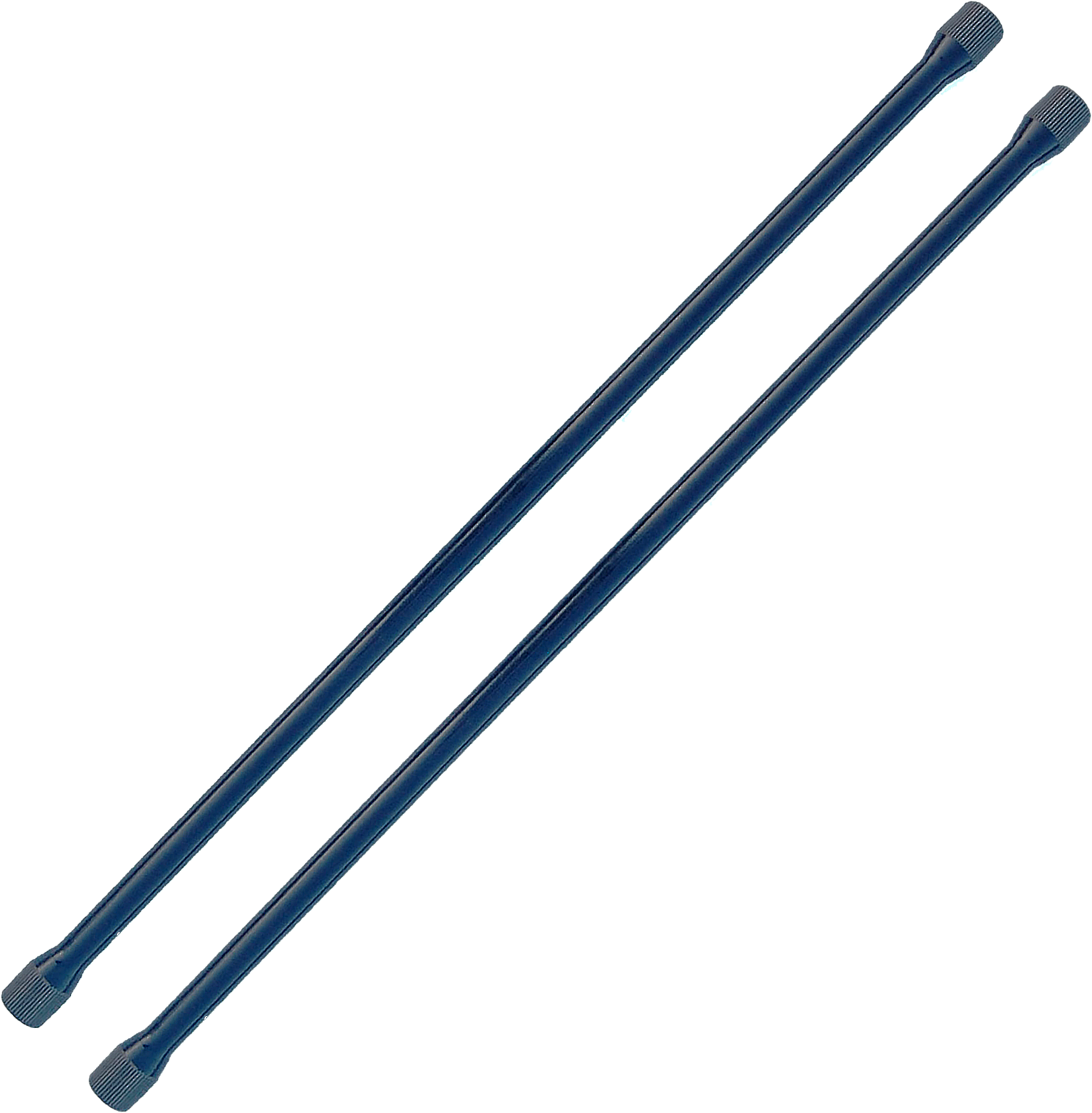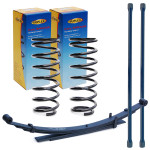Local Storage seems to be disabled in your browser.
For the best experience on our site, be sure to turn on Local Storage in your browser.
The difference between Coil, Leaf & Torsion Bars
In this article you will learn about different suspensions types such as coil springs, leaf springs and torsion bar suspension systems, their functions and how their differ from one another. A vehicle ride quality is a very personal preference, and what one persons opinion of a nice ride comfort and feel will be another ones nightmare.
Automotive springs & torsion bars play a major role in the safe handling and ride comfort of your vehicle. Not only do they keep a vehicle at a designated standing height, they provide recoil necessary to bounce back after suspension components move up and down over uneven road surfaces. By themselves, they will continue to bounce up and down for a long time unless shock absorber is present to keep things stable.
The springs in your vehicle probably aren't something you think about until there's a problem or you've decided to upgrade suspension parts in the interest of firmer handling, suspension lift or even if you want to lower the vehicle. When it comes to basic suspension setups there are three main types -Coil springs, leaf springs & torsion bars.
Coil Springs

Coil springs are made from hardened and tempered steel, wound in a spiral formation. Most modern passenger cars built in the last few decades feature coil springs at all four wheels, and an increasing number of pickups and SUVs are now equipped with them in the front as well as the rear. On coil over struts or otherwise known as MacPherson type struts, a coil spring is mounted around a shock absorber - both of which are mounted to the strut. On other vehicles without struts, coil springs and shock absorbers are mounted separately.
Coil springs can be firm, soft, or have a spring rate that varies. As a pound-per-square-inch measurement, spring rate is the force required to compress a coil spring 1 inch. The higher the per-inch spring rate, the stiffer the spring. Spring rate is also used to describe whether a spring has the same rate of compression at all points during its travel ("linear"), gets progressively stiffer the more it compresses ("progressive"), or is specially configured to change characteristics abruptly ("dual rate").
Advantages of Coil Springs
Coil springs allow the most flexibility when it comes to variable rate characteristics. For trucks, variable rate coil springs allow a comfortable ride when the vehicle is unloaded. As weight is added, the spring rate becomes stiffer to increase stability without the ill effects of bouncing, and it prevents the ride height from dropping significantly.
For performance-oriented cars with a low ride height, variable rate springs allow better absorption of bumps during normal street use, then become stiffer around turns to reduce body roll during aggressive driving. Coil springs can also allow for a greater amount of up and down wheel travel, which is a huge advantage on rutted and rocky off-road trails.
Disadvantages of Coil Springs
Coil springs aren't as well suited to carrying heavy loads as leaf springs are. With coil springs, vehicle weight is concentrated onto a smaller surface area of the chassis, while leaf springs spread a load out more evenly. To save overall weight on cars that keep getting heavier with additional standard and optional equipment, some manufacturers have taken to making coil springs lighter and thinner. Unfortunately, this makes them more subject to cracking and breaking under pressure - especially if corrosion sets in.
What would be non-threatening surface rust on more robust springs can cause thinner ones to be significantly compromised. Some vehicle manufacturers have applied durable surface coatings around the springs - both for corrosion resistance and to prevent any broken shards from flying loose and puncturing tires or sometimes even worse.
How to Tell When Coil Springs Are Worn
When an entire front or rear of a vehicle sags evenly, worn out springs are usually the cause. Uneven ride height from side-to-side is often a sign of broken or saggy springs. Like all types of springs, coil springs are subject to corrosion. Because coil spring windings are typically thinner than leaf springs or torsion bars are, breakage such as this can occur in worst-case scenarios.
As coil springs age, they naturally lose their resilience and start to sag, causing ride height to drop. So if your vehicle droops at the front or rear, those springs are probably worn out. If there's a noticeable difference in ride height between the left and right side of the vehicle, a coil spring may be broken. Either of these problems will become especially obvious when even a small amount of weight is added - such as one or two passengers in the rear seat. Broken coil springs also tend to generate some kind of noise as things shift.
Because coil springs are often fitted to vehicles with more sophisticated independent, multi-link suspension systems, improper ride height has more of a negative effect on wheel alignment and tire wear. If you think your ride height may be sagging, ride height specifications can be found on the internet. It's easy to make a measurement yourself for comparison purposes.
When you think it's time to replace those coil springs, we've got a wide range of replacement standard height coil springs as well as coil springs to enhance the vehicles ride height under our Coil Spring Suspension category. Every coil spring we supply are manufactured pecifically for RoughTrax with spring rates, design and specifications taken from the original Toyota coil spring, this way you can be assured the pig tailing, quality of materials & thickness of the coil will be as per the original or uprated for enhanced performance.
Leaf Springs
 Leaf springs are literally older than the motor vehicles itself, having been in use since the earliest horse-driven carriages travelling the countryside. Very simple in layout, a leaf spring setup is composed of one or more lengths of arched spring steel. Each arched steel piece is known as a leaf, and one or more leaves may be stacked on top of each other and mounted above or below a solid axle (non-independent). Because they are bolted to the axle, leaf springs support the weight of the vehicle and serve to secure the axle to the chassis.
Leaf springs are literally older than the motor vehicles itself, having been in use since the earliest horse-driven carriages travelling the countryside. Very simple in layout, a leaf spring setup is composed of one or more lengths of arched spring steel. Each arched steel piece is known as a leaf, and one or more leaves may be stacked on top of each other and mounted above or below a solid axle (non-independent). Because they are bolted to the axle, leaf springs support the weight of the vehicle and serve to secure the axle to the chassis.
Multi-Leaf Springs
A single leaf setup typically found on small lightweight cars is known as a "mono leaf" spring, while multiple leaves stacked on top of each other are known as "multi leaf" springs. Both types of setups have a "main leaf" that features curved ends with round bushings built into them known as eyelets.
On multi-leaf setups where additional leaves become progressively shorter in length, the longest leaf serves as the main attachment leaf. While the front eye of the main leaf is typically mounted directly to the vehicle chassis, shackles are often used at the rear to allow flex as the leaf springs elongate under compression. One end of the shackle is attached to the vehicle chassis, the other to the rear eye.
Leaf springs are best suited to heavy vehicles that carry large payloads, they're most commonly found on solid axles of pickups, SUVs, and larger trucks not equipped with air suspension. On these vehicles as well as older body-on-frame cars, leaf springs are mounted parallel with the chassis rails from front-to-rear.
Advantages of Leaf Springs
Leaf springs are the simplest setup, with the fewest number of moving parts to wear out. Unlike coil springs, leaves serve to keep the rear axle in place so the need for complex suspension linkages are eliminated. When a lot of weight is being carried, leaf springs spread the load out more evenly across the vehicle's chassis than coil springs or torsion bars.
Additionally, the friction produced between multiple leaves as they slide helps damp the natural up-down rebounding effect of springs - making the ride steadier and reducing the work that shock absorbers must do.
Disadvantages of Leaf Springs
Axle wind-up can be a problem with leaf springs. As torque transferring from the rear axle through the leaf spring contorts the front half of the spring, it twists then untwists - creating a back-and-forth ricochet of energy between the front and rear of the spring. This is known as "wheel hop", because it causes tyres to literally hop up and down and lose traction.
When leaf springs are bolted directly to rear axles, torque generated during hard acceleration or braking can cause axle wind-up which creates vibration, rear-end squat, and nose-diving. This mounting also requires leaf springs to have a stiffer spring rate - reducing ride comfort levels that softer springs would provide.
How to Tell When Leaf Springs Are Worn
If you feel your leaf springs aren't performing the way they should, check for broken or missing leaves.
When worn leaf springs lose their resilience, they begin to sag. Vehicle ride height drops as a direct result, so it's a good idea to measure ride height yourself and compare specifications if you feel there's a problem. Along with a low ride height and lost spring bounce come complications such as bottoming out much easier over bumps - something that's harmful to suspension components and possibly to your payload.
When leaf springs become worn, the leaves can develop visible cracks and corrosion. Sometimes if corrosion and wear are bad enough, a leaf can break in two - with a section of it falling off the vehicle entirely. When rubber bushings in spring eyelets and shackles dry up and crumble, cushioning is lost and ride harshness significantly increases.
You can view alternatives for replacement leaf springs under our Leaf Spring Suspension category, we have a wide range of standard uprated replacements and leaf springs to enhance the vehicles ride height. Every leaf spring we supply are manufactured specifically for RoughTrax in the UK with spring rates, design and specifications taken from the original Toyota leaf spring, this way you can be assured the quality of materials & thickness of the leafs will be as per the original or heavy duty for enhanced performance.
Torsion Bars
 Torsion Bars don't flatten out like a leaf spring or compress like a coil spring. Instead, a narrow steel tube attached to the vehicle's wishbone twists along its axis, or length, when that wishbone travels up and down. The other end, bolted to the vehicles chassis, is fixed in place and does not twist. When a wheel strikes a bump and moves upward, tension is created as the bar twists out of shape. After the bump, the steel bar unwinds and pushes the wheel downwards again. Torsion bars are typically mounted in a front-to-rear position on the vehicle, allowing bars to have greater length for more up-and-down wheel travel on 4x4s.
Torsion Bars don't flatten out like a leaf spring or compress like a coil spring. Instead, a narrow steel tube attached to the vehicle's wishbone twists along its axis, or length, when that wishbone travels up and down. The other end, bolted to the vehicles chassis, is fixed in place and does not twist. When a wheel strikes a bump and moves upward, tension is created as the bar twists out of shape. After the bump, the steel bar unwinds and pushes the wheel downwards again. Torsion bars are typically mounted in a front-to-rear position on the vehicle, allowing bars to have greater length for more up-and-down wheel travel on 4x4s.
The attachment ends of torsion bars are usually splined, and mounted in an anchor piece known as a "key". The position of these keys can be adjusted with the torsion bar bolt to vary a vehicle's overall ride height. As the bolt is turned to the raised position, the ride height of the vehicle increases - or vice versa. Spring rates of torsion bars are determined by a bar's thickness, overall diameter, length, and the material it's made out of (usually steel alloy).
Advantages of Torsion Bars
Because torsion bars are very space-efficient and take up much less overall volume, drive axles and other suspension components can be located where other types of springs would be in the way. And because ride height can easily be adjusted, it allows the vehicles owner to set it to their own taste. Additionally, adjusting a torsion bars to raise the ride height when the have started to wear will extend their useful lifespan - while maintaining proper ride height that doesn't interfere with alignment and tire wear.
Disadvantages of Torsion Bars
Because torsion bars are mounted low along the vehicle's underside, they can be more likely damaged by speed bumps, debris in the road, and uneven terrain. It's important to visually inspect them for damage in the event they have become bent, scraped or cracked.
How To Tell When Torsion Bar Springs are Worn
Sagging ride height is the most common indicator of worn torsion bars, along with a harsher ride quality because the bars lose their range of twist (torsion). If you're ready to review your choices for replacement torsion bars.
You can view alternatives for replacement torsion bars under our Torsion Bar Suspension category, we have a range of standard uprated replacements to enhance the vehicles ride for standard height or lifted vehicles.
Replacement Coil Springs, Leaf Springs & Torsion Bars
Whether your vehicle uses coil springs, leaf springs or torsion bars (or a combination) replacing them will bring noticeable "quality-of-life" improvements that you'll feel in your hands and in your seat. New springs or torsion bars will bring back its handling as the engineers intended it or with a performance improvement.
If performance handling is your focus, upgrading your springs will give you the full value out of more bigger wheels, tires, shocks, and other suspension components. If you're replacing other suspension components anyway, it's penny-wise and pound-foolish to keep your worn-out original springs in place.
To help guide you through the selection of springs and other suspension components we offer for your vehicle, we have specifically built our website to provide you with a huge selection of choice to fit your Toyota's with detailed descriptions, specifications and fitments on all Toyota Suspension Parts.
